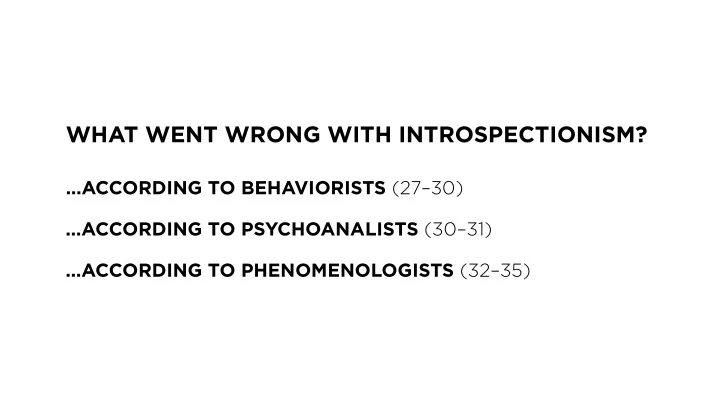

WHAT WENT WRONG WITH INTROSPECTIONISM? …ACCORDING TO BEHAVIORISTS (27–30) …ACCORDING TO PSYCHOANALISTS (30–31) …ACCORDING TO PHENOMENOLOGISTS (32–35)
3.1 IRRATIONAL BEHAVIOR What does it mean for behavior to be “rational”? What are some examples of irrational behavior? Why does the existence of irrational behavior pose a problem to Cartesians and introspectionists?
3.2 THE CONCEPT OF THE UNCONSCIOUS Unconscious cause of behavior vs. unconscious mental state? Why did psychologists initially accuse Freud of self contradiction?
3.3 THE EXISTENCE OF THE UNCONSCIOUS Observation terms vs. theoretical terms Does becoming conscious of a sensation create it, or are you noticing something that was already there? Unconsciously seeing a stop sign vs. seeing and immediately forgetting The problem of empirically equivalent theories Evidence from Cognitive Science: Lackner & Garrett (1972)
3.4 OTHER MINDS What is the problem of other minds? Why is it a weak generalization to assume that others’ experiences are like my own? Reports of mental states vs. other behavioral evidence Parapraxes (Freudian slips)
3.5 RESISTANCE What did Freud mean by “resistance”? How did he explain it? Why doesn’t it matter whether Freud’s modules are localized in the brain? Functionalism
the pleasure principle: wish → pain → activity → wish fulfillment → pleasure two modifications: wish → pain → affective discharge → partial and temporary pain reduction wish → pain → hallucinatory wish fulfillment → partial and temporary pain reduction a third: wish → pain → delay of wish fulfillment → activity → wish fulfillment → pleasure
id ego superego primary process thinking secondary process thinking defense mechanisms repression
Karl Popper Conjectures and Refutations
Popper’s Criteria for Good Science (1) It is easy to obtain confirmations, or verifications, for nearly every theory—if we look for confirmations. (2) Confirmations should count only if they are the result of risky predictions; that is to say, if, unenlightened by the theory in question, we should have expected an event which was incompatible with the theory—an event which would have refuted the theory. (3) Every 'good' scientific theory is a prohibition: it forbids certain things to happen. The more a theory forbids, the better it is. (4) A theory which is not refutable by any conceivable event is nonscientific. Irrefutability is not a virtue of a theory (as people often think) but a vice.
Popper’s Criteria for Good Science (5) Every genuine test of a theory is an attempt to falsify it, or to refute it. Testability is falsifiability; but there are degrees of testability: some theories are more testable, more exposed to refutation, than others; they take, as it were, greater risks. (6) Confirming evidence should not count except when it is the result of a genuine test of the theory; and this means that it can be presented as a serious but unsuccessful attempt to falsify the theory. (I now speak in such cases of 'corroborating evidence'.) (7) Some genuinely testable theories, when found to be false, are still upheld by their admirers--for example by introducing ad hoc some auxiliary assumption, or by re- interpreting the theory ad hoc in such a way that it escapes refutation. Such a procedure is always possible, but it rescues the theory from refutation only at the price of destroying, or at least lowering, its scientific status. (I later described such a rescuing operation as a 'conventionalist twist' or a 'conventionalist stratagem'.)
Recommend
More recommend